高一上学期英语教案:Unit 1Using Language
外研选择性必修一Unit1_Using_language_板块教学设计
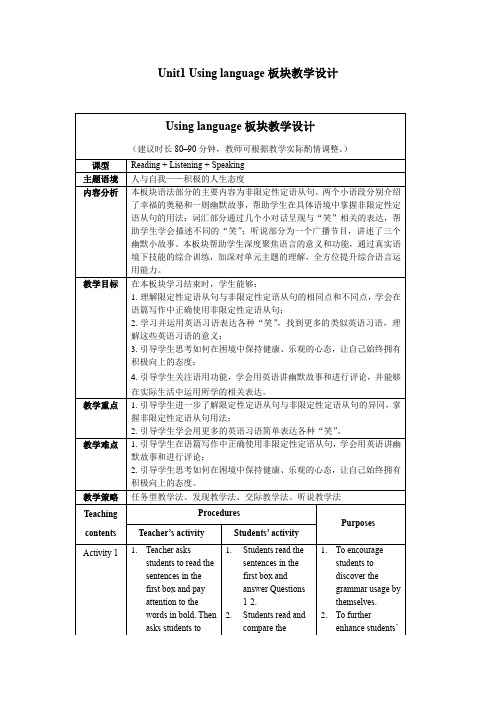
2.引导学生思考如何在困境中保持健康、乐观的心态,让自己始终拥有积极向上的态度。
教学策略
任务型教学法、发现教学法、交际教学法、听说教学法
Teaching contents
Procedures
Purposes
Teacher’s activity
Students’activity
Activity 1
1.Teacher asks studentsto readthe sentences in the first boxand payattention to the words in bold. Then asksstudents toanswer Questions 1-2.
4.Teacher asks students to look for more sentences with the similar structures in the reading passage, and helps students to summarise the uses of non-defining attributive clauses.
1.Studentsreadthe sentences in the first boxandanswer Questions 1-2.
2.Students read and compare theexample sentences again to answerQuestion 3.
3.Students conclude the uses of non-defining attributive clauses and the similarities and differences of defining attributive clauses and non-defining attributive clauses.
高中英语 unit1 Using language教案
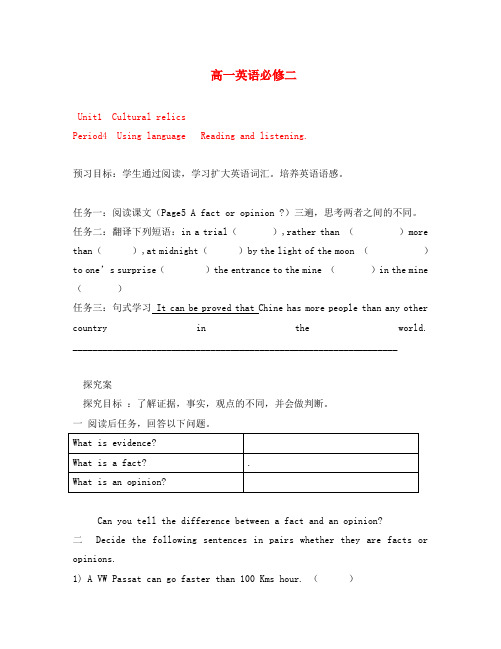
高一英语必修二Unit1 Cultural relicsPeriod4 Using language Reading and listening.预习目标:学生通过阅读,学习扩大英语词汇。
培养英语语感。
任务一:阅读课文(Page5 A fact or opinion ?)三遍,思考两者之间的不同。
任务二:翻译下列短语:in a trial(),rather than ()more than(),at midnight()by the light of the moon ()to one’s surprise()the entrance to the mine ()in the mine ()任务三:句式学习 It can be proved that Chine has more people than any other country in the world. __________________________________________________________________探究案探究目标:了解证据,事实,观点的不同,并会做判断。
一阅读后任务,回答以下问题。
Can you tell the difference between a fact and an opinion?二 Decide the following sentences in pairs whether they are facts or opinions.1)A VW Passat can go faster than 100 Kms hour. ()2)I think it’s the best car for a family. ()3)I think drinking a car is wrong because is causes damage to the environment.()4)I don’t like public transport because it’s so crowded.( )5)I know that driving a car spoils the air in Beijing. ()6)The Beijing Olympic Games were the best ever. ()三阅读Page5 part2.完成Page5 part3表格。
高一英语必修一unit1教案
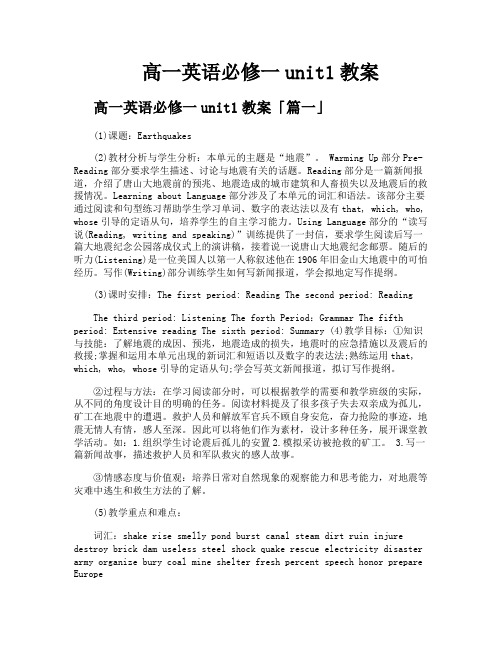
高一英语必修一unit1教案高一英语必修一unit1教案「篇一」(1)课题:Earthquakes(2)教材分析与学生分析:本单元的主题是“地震”。
Warming Up部分Pre-Reading部分要求学生描述、讨论与地震有关的话题。
Reading部分是一篇新闻报道,介绍了唐山大地震前的预兆、地震造成的城市建筑和人畜损失以及地震后的救援情况。
Learning about Language部分涉及了本单元的词汇和语法。
该部分主要通过阅读和句型练习帮助学生学习单词、数字的表达法以及有that, which, who, whose引导的定语从句,培养学生的自主学习能力。
Using Language部分的“读写说(Reading, writing and speaking)”训练提供了一封信,要求学生阅读后写一篇大地震纪念公园落成仪式上的演讲稿,接着说一说唐山大地震纪念邮票。
随后的听力(Listening)是一位美国人以第一人称叙述他在1906年旧金山大地震中的可怕经历。
写作(Writing)部分训练学生如何写新闻报道,学会拟地定写作提纲。
(3)课时安排:The first period: Reading The second period: ReadingThe third period: Listening The forth Period:Grammar The fifth period: Extensive reading The sixth period: Summary (4)教学目标:①知识与技能:了解地震的成因、预兆,地震造成的损失,地震时的应急措施以及震后的救援;掌握和运用本单元出现的新词汇和短语以及数字的表达法;熟练运用that, which, who, whose引导的定语从句;学会写英文新闻报道,拟订写作提纲。
②过程与方法:在学习阅读部分时,可以根据教学的需要和教学班级的实际,从不同的角度设计目的明确的任务。
2023外研版英语必修一unit1 using language教案

2023外研版英语必修一unit1 using language教案
一、教学目标:
1. 学生能够理解和使用单元主题相关的词汇和表达方式。
2. 学生能够掌握本单元中使用的语法结构和句式。
3. 学生能够运用所学知识进行口头和书面表达,提高英语综合能力。
二、教学内容:
本单元的Using Language部分包括一篇阅读文章和相应的练习。
阅读文章主要讲述了一位学生在学校图书馆发现了一本神奇的书,通过这本书,他获得了许多有趣的知识和技能。
文章中涉及到的语法结构和词汇都比较丰富,学生可以通过阅读和练习来巩固所学知识。
三、教学步骤:
1. 导入:首先,通过简单的对话或问题引入本单元的主题和阅读文章的内容。
2. 词汇学习:讲解文章中出现的生词和短语,帮助学生理解和记忆。
可以通过图片、视频、例句等方式进行展示和讲解。
3. 阅读理解:让学生阅读文章,并回答提前准备的一些问题,检查学生对文章的理解程度。
4. 语法结构学习:讲解文章中使用的语法结构和句式,可以通过例句、练习等方式进行巩固和练习。
5. 练习完成:让学生完成一些与文章相关的练习题,如填空、选择、改写句子等,以检验学生的学习成果。
6. 总结回顾:最后,回顾本节课所学的内容和重点,鼓励学生运用所学知识进行口头和书面表达。
四、教学反思:
课后,教师需要对本节课的教学情况进行反思,找出不足和需要改进的地方,以提高教学效果。
以上就是《2023外研版英语必修一unit1 using language教案》的教学思路,希望能对您有所帮助。
Unit 1 Using Language(教学设计)-高中英语人教版(2019)选择性必修一
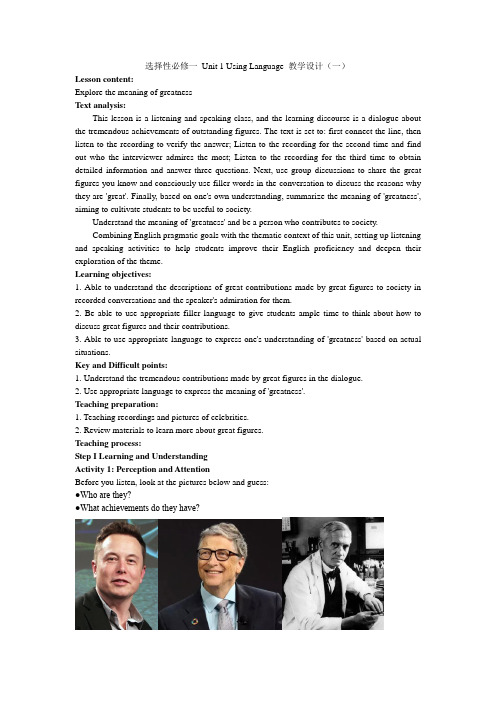
选择性必修一Unit 1 Using Language 教学设计(一)Lesson content:Explore the meaning of greatnessText analysis:This lesson is a listening and speaking class, and the learning discourse is a dialogue about the tremendous achievements of outstanding figures. The text is set to: first connect the line, then listen to the recording to verify the answer; Listen to the recording for the second time and find out who the interviewer admires the most; Listen to the recording for the third time to obtain detailed information and answer three questions. Next, use group discussions to share the great figures you know and consciously use filler words in the conversation to discuss the reasons why they are 'great'. Finally, based on one's own understanding, summarize the meaning of 'greatness', aiming to cultivate students to be useful to society.Understand the meaning of 'greatness' and be a person who contributes to society.Combining English pragmatic goals with the thematic context of this unit, setting up listening and speaking activities to help students improve their English proficiency and deepen their exploration of the theme.Learning objectives:1. Able to understand the descriptions of great contributions made by great figures to society in recorded conversations and the speaker's admiration for them.2. Be able to use appropriate filler language to give students ample time to think about how to discuss great figures and their contributions.3. Able to use appropriate language to express one's understanding of 'greatness' based on actual situations.Key and Difficult points:1. Understand the tremendous contributions made by great figures in the dialogue.2. Use appropriate language to express the meaning of 'greatness'.Teaching preparation:1. Teaching recordings and pictures of celebrities.2. Review materials to learn more about great figures.Teaching process:Step I Learning and UnderstandingActivity 1: Perception and AttentionBefore you listen, look at the pictures below and guess:●Who are they?●What achievements do they have?【设计意图】在学习之前,呈现伟大人物的图片,并简单讨论他们的成就,激活学生的背景知识。
Unit1Laughoutloud!Usinglanguage教案高中英语选择性

Unit 1 Laugh out loud!Using language教学设计科目:英语课题:Using language 课时:1课时教学目标与核心素养:知识目标:Students can learn some new words and basic sentence structures.能力目标:Students can have a further understanding of the passage.情感目标:Students can think individually and learn cooperatively.教学重难点:教学重点:How to learn the new words and basic sentence structures.教学难点:How to make students have a better understanding of the passage.课前准备:多媒体,黑板,粉笔教学过程:一、Presentation1. Greeting2. Leadingin教师活动:教师提问。
What kind of clauses do you know?二、practiceUsing Language1. 学生活动:plete Activity 1 on Page 6.Look at the sentences from the reading passage and answer the questions:Suggested answers:•In sentence (a) "where" refers to " the waiting area"; in sentence (b) "which" refers to "... laughter produces chemicals to make people feel better"; in sentence (c) "when" refers to "the time".•Sentence ( c) contains a clause with essential information, sentences (a) and (b) contain clauses with extra information, If we take away the clause of sentence(c), the meaning of it is inplete. If we take away the clauses of sentences (a) and (b), the two sentences still make sense.•Sentences (a) and (b) with extra information are separated by mas.2. 学生活动:Look for more sentences with nondefining attributive clauses in the reading passage, and summarize their uses in their own words.3. 教师活动:语法讲解Nondefining attributive clauses——非限制性定语从句根据定语从句与先行词之间关系的密切程度,我们将定语从句分为限制性定语从句和非限制性定语从句两种。
外研版高一英语必修第一册(2019版)_Unit1_Using_Language_板块教学设计
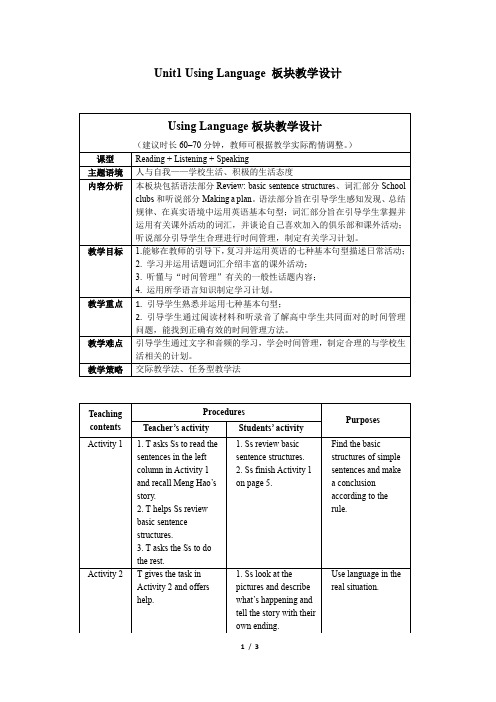
Using Language板块教学设计
(建议时长60–70分钟,教师可根据教学实际酌情调整。)
课型
Reading+Listening+Speaking
主题语境
人与自我——学校生活、积极的生活态度
内容分析
本板块包括语法部分Review:basic sentence structures、词汇部分School部分旨在引导学生感知发现、总结规律、在真实语境中运用英语基本句型;词汇部分旨在引导学生掌握并运用有关课外活动的词汇,并谈论自己喜欢加入的俱乐部和课外活动;听说部分引导学生合理进行时间管理,制定有关学习计划。
Ss work in pairs. Talk about the school clubs they would like to join and the activities they can do in them. And create new clubs asif theywish.
Practice oral English according to the theme of this unit.
Ss make another weekend plan and have a similar conversation.
Furtherpractiseexchanging ideas.
教学目标
1.能够在教师的引导下,复习并运用英语的七种基本句型描述日常活动;
2.学习并运用话题词汇介绍丰富的课外活动;
3.听懂与“时间管理”有关的一般性话题内容;
4.运用所学语言知识制定学习计划。
教学重点
1.引导学生熟悉并运用七种基本句型;
高中英语必修第一册Unit 1 A new start-Using language教案

1) Look atthe sentenceandanalyseit.
2)Try to know the importance of the basic sentence structures.
2) To prepare for the next class.
Blackboard design
Unit 1Using language
1. SV
2.SVO
3.SVP
4.SVOo
5.SVOC
●Ability objectives:
efivebasic sentence patterns to describe daily activities.
edifferent basic sentence structuresto write a story.
●Emotional objective:
2. TocultivateSs' spirit of exploration.
Teaching methods
In this lesson, communicative approach and cooperation-study method are adopted in order to improveSs’grammarandwriting skills.
3)Give the task in Activity 2 and offers help.
1)Write the basic sentence structures.
必修一Unit 1 Using Language教案
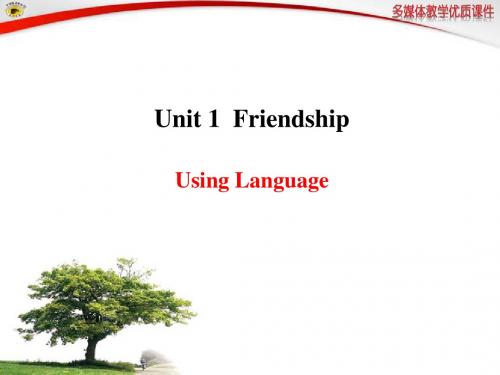
countryside. F (3) She stays in the best hotel in town. T (4) Most people invite her to their homes as a guest. F
Part 2 Talking (1) What does she think of Chinese people? Do you agree
A. Ignore the boy.
B. Ignore her classmates.
C. Ignore her gossiping classmates.
Listening again and write the answers
being 1. There’s nothing wrong with you and this boy ______
studying friends and ________ together.
Ending 2. _______ your friendship with this boy would be a stupid ______ thing to do. gossip 3. Teenagers like to ______, and they often see something that isn’t real. ignore 4. My advice is to ______ your classmates. That way grown-up show you will ______ them that you are more _________ than they are.
the 2nd listening
Choose the best answer.
Unit 1 Using language(教学设计)高中英语人教版(2019) 选择性必修第一册
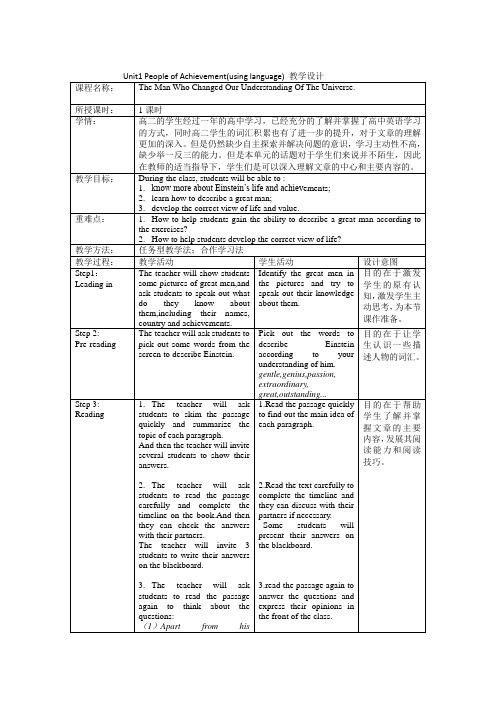
gentle,genius,passion, extraordinary, great,outstanding...
目的在于让学生认识一些描述人物的词汇。
(2)Find the descriptions that tell us what Einstein looked like and what kind of person he was?
目的在于培养学生的探索思维和举一反三的能力,同时发展学生的合作学习能力。
Step5:
Writing
The teacher will ask students to find out the useful expressions from the passage that will be used to describe someone.
The teacher will invite 3 students to write their answers on the blackboard.
3.The teacher will ask students to read the passage again to think about the questions:
1.Read the passage quickly to find out the main idea of each paragraph.
2.Read the text carefully to complete the timeline and they can discuss with their partners if necessary.
2020_2021学年高中英语Unit1教案外研版必修第一册

Unit 1 A new start
第一步:学生首先看海报上的图片并阅读文字内容,理解文
本大意。
引导学生关注海报的非文本信息。
第二步:根据海报内容,学生完成选词填空。
提醒学生使
用单词的正确形式。
第三步:全班核对答案,请学生分享自己感兴趣或希望加
入的俱乐部活动。
参考答案
1 Badminton
2 gym
3 Drama
4 stage
5 piano
6 band
7 Debate 8 Science 9 Photography
Step3 While-listening
教师带领学生听第一遍录音,理解对话大意,选出对话的主要内容。
1.Listen to the conversation and decide what the speakers are mainly talking about.
1) The clubs they have joined and the activities they do after school.
2) The things they should do to manage their time well.
3)The challenges they face in their new school.
教师可根据班级情况多次播放录音,引导学生获取对话细节并完成填空。
2019新人教高中英语选择性必修一Unit1Using Language(p6-p9)公开课教案
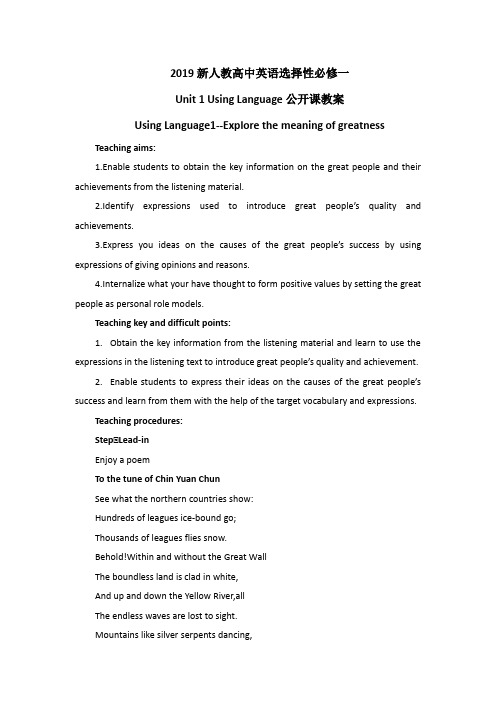
2019新人教高中英语选择性必修一Unit 1 Using Language公开课教案Using Language1--Explore the meaning of greatness Teaching aims:1.Enable students to obtain the key information on the great people and their achievements from the listening material.2.Identify expressions used to introduce great people’s quality and achievements.3.Express you ideas on the causes of the great people’s success by using expressions of giving opinions and reasons.4.Internalize what your have thought to form positive values by setting the great people as personal role models.Teaching key and difficult points:1.Obtain the key information from the listening material and learn to use the expressions in the listening text to introduce great people’s quality and achievement.2.Enable students to express their ideas on the causes of the great people’s success and learn from them with the help of the target vocabulary and expressions.Teaching procedures:StepⅠLead-inEnjoy a poemTo the tune of Chin Yuan ChunSee what the northern countries show:Hundreds of leagues ice-bound go;Thousands of leagues flies snow.Behold!Within and without the Great WallThe boundless land is clad in white,And up and down the Yellow River,allThe endless waves are lost to sight.Mountains like silver serpents dancing,Highlands like waxy elephants advancing,All try to match the sky in height.Wait till the day is fineAnd see the fair bask in sparkling sunshine,What an enchanting sight!Our motherland so rich in beautyHas made countless heroes vie to pay her their duty.But alas!Qin Huang and Han WuIn culture not well bred,And Tang Zong and Song ZuIn letters not wide read.And Genghis Khan,proud son of Heaven for a dayKnew only shooting eagles by bending his bows.They have all passed away;Brilliant heroes are thoseWhom we will see today!T:Dear class,let’s read the poem together. Do you know who wrote it? Which part do you like best? Why?Ss: It was written by Chairman Mao. I like the last sentence. Because it emphasises the important role that the present great people play and gives us the confidence in the present age.T:Yes, the age needs heroes and heroes create the age,too.So let’s know more about those great people and their achievement.StepⅠListening practiceActivity 1Match the people with their achievements.(1)Elon Musk A.founder of modern nursing(2)Bill Gates B.founded high-tech and futuristic companies(3)Jack Ma(Ma Yun) C.managed the SARS outbreak(4)Alexander Fleming D.made great advancement in online shopping(5)Florence Nightingale E.made home computing accessible(6)Zhong Nanshan F.discovered penicillinSuggested answers:(1)—B(2)—E(3)—D(4)—F(5)—A(6)—CActivity 2Fill in the blanks.(1)Elon Musk:He is the guy who founded a private space company,and also some other companies.He’s made .He is trying to help the of humankind.(2)Bill Gates & Jack Ma:They are really ,too.Just think of all the money they make.They have contributions to society.Bill Gates has given us home and Jack Ma makes it so easy to .(3)Zhong Nanshan:He is our ,who managed the SARS outbreak.Suggested answers:(1)millions of dollars;future(2)smart;positive;computing;shop online (3)personal heroActivity 3Listen to the conversation again.Who does each speaker admire?Tick in the table below.(红色为学生填写部分)Dr Wang Wang Lin Anna SmithElon Musk√Bill Gates√√Jack Ma√Zhong Nanshan√Florence Nightingale√Alexander Fleming√Dr Wang√Activity 4Listen again and answer the questions.(1)Why does Dr Wang say “money isn’t everything”?(2)What is the real reason Anna admires the famous people,and what examples does she give?(3)What kind of person do you think Wang Lin admires?Why?Suggested answers:(1)Because some people like Alexander Fleming,Florence Nightingale and Zhong Nanshan don’t make millions of money,but their contributions to health care have saved uncounted lives.(2)The real reason is that those people have worked so hard to achieve their goals and made uncounted contributions to society.She gives the examples of Elon Musk and Bill Gates.(3)She admires those who do good things inspiring her and her life.Because she lists the examples of Jack Ma and her father.StepⅢPost-listeningFinish the summary of the whole listening material.StepⅣTalkingActivity 1 Prepare small notes with deeds of celebrities, with one celebrity on each note,and let one student read the descriptions,other students guess who it is,and then classify according to the table and write them in the table below.Well,①er,...③ReallyYeah,I mean,I understand what you're saying...Well,I guess...Anyway,.. You see/know,... Just a moment. So,...Hang on a second.Well,it's on the lip of my tongue.May I think about that for a momentI've nearly got it,er,...How can/shall/should I put this/itWhat I want to say is...Let me think about this/that for a moment.Use the tip-list to help each other express your thoughts and ideas in a reasonable and complete way.(1)Body language:stand straight,proper gestures and eye contact with the audience.(2)Think for seconds before you speak out.(3)Use proper language fillers above to fill your stop time.(4)Give a summary of what you have introduced at the end of your introduction.Suggested answer:Jack:Bill,what makes these people great Bill:Um,may I think about that for a moment Jack:Jim,what's your opinion about itJim:I think it's the persistence that makes them great just like the father of India,er,...It's on the tip of my tongue,but...Bill:Mahatma Gandhi.Jim:Right.Bill:Besides,I guess it's also their wisdom that keeps them free from the dangers like Mao Zedong.Jack:You are both right.Activity 3 Use the discussion to draw conclusions about the meaning of greatness. The following expressions may help you. Then report back to the class.Suggested answer:Hello,everyone! The greatest person I know of is Dr Zhong Nanshan,who managed the SARS outbreak in China in 2003. Now it's he who prevented the COVID-19 from quick spread all over the country once again. To me, greatness means sacrifice and devotion. Dr Zhong Nanshan took risks entering the isolated area to cure the patients,summarizing the infected but recovered cases and sharing his successful experience with other home and abroad doctors. He serves as a good role model and makes great contributions to society. That's all. Thank you!Using Language2--Introduce someone you admire Teaching aims:1.Enable students to learn Albert Einstein’s life and his achievements.2. Figure out the organization and language features of the text.3.Identify how to introduce someone you admire.4. Write an introduction about someone you admire.Teaching key and difficult points:1.Enable students to figure out the organization and language features of the text2.Guide students to write an introduction about someone they admire.Teaching proceduresStepⅠLead-inReview some achievement of Tu Youyou and show the description of another man’s achievements.Ask the students guess who he is.StepⅠWhile-readingActivity1 Read for predictionsLook at the title and picture and predict what kind of article this is?The text mainly talks about Einstein’s and .Suggested answers:life;achievementsActivity2 Read for the detailed information1.Which of the following about Albert Einstein are not included in the passage?A.his achievementsB.his familyC.his characterD.his experiencesE.his hobbiesF.his appearanceG.his death H.his wife and childrenSuggested answers: B E H2.Read the passage again and complete the timeline.Suggested answers:Activity 3 Discuss the following questions in pairs1.Apart from his remarkable achievements,what does the passage tell us about Einstein’s life?2.What impressed you most about Einstein?State your reasons.Suggested answers:1.Although world-famous,he was still an ordinary and funny person who was also full of a childish and warm heart.2.When faced with failure or difficulties,he didn’t give up and chose to workhard to achieve his dream.For example,he failed in the entrance exam,but he chose to study harder for another year to achieve his dream.Moreover,because he was Jewish when Hitler came to power,the doors of academic institutions were closed to him.But after he succeeded in moving to America,he made great achievements in physics and mathematics.Activity 4Read for the organization and language features1.What type of writing is this text?How does the writer develop the text?2.Find the descriptions that tell us what Einstein looked like and what kind of person he was.3.What rhetorical devices are used in the passage?Give examples.Suggested answers:1.The text is a biography,which is developed chronologically.2.He had a thick moustache and long white hair,which sometimes stood on end as though he had just received an electric shock.Although he was a genius, he sometimes forgot things, like his friends’ birthdays.But despite his peculiarities, he was loved by his friends and neighbours.There is even a story about how he helped a little girl who knocked on his door and asked for help with her homework.In fact, Einstein often encountered people on the street who would stop him and ask him to help explain things.After many such occasions, he finally started saying, “Pardon me! Sorry! Always I am mistaken for Professor Einstein!”3.Analogy:as the new Isaac Newton;personification:long white hair,which sometimes stood on end;simile:as though he had just received an electric shock;metaphor:the doors of academic institutions;euphemism:passed away.StepⅠ Write an introduction about someone you admire1.Choose the person you are going to write about.It should be someone you think is great in some way.It can be an ordinary person,such as a parent,a relative,ora friend.2.Make a list of things that need to be included in your introduction.e your notes to write your introduction and sum up how you feel about this person.Writing material:请根据以下材料,写一篇介绍我国明代(the Ming Dynasty)医学家(medical scientist)李时珍的文章。
2023外研版英语必修一unit1using language教案

2023外研版英语必修一unit1using language教案
一、教学目标:
1. 学生能够理解Using Language部分的内容和语境,能够正确使用相关的语言表达。
2. 学生能够通过阅读和讨论,提高跨文化交际的能力。
3. 学生能够通过小组活动,提高合作和沟通能力。
二、教学内容:
本单元的Using Language部分包括一篇阅读文章和相关的语言练习。
阅读文章主要讨论了不同文化背景下的人际交往方式,学生需要通过阅读和讨论,了解不同文化背景下语言表达的差异,并能够在实际生活中正确使用。
三、教学步骤:
1. 导入(5分钟):先引导学生回顾必修一第一单元的学习内容,再引入本单元的话题:不同文化背景下的语言交际。
2. 阅读文章(15分钟):让学生阅读文章,并解释文章中的一些重点词汇和表达。
3. 语言练习(20分钟):进行相关的语言练习,例如填空、选择题、作文等。
在练习中,应注意突出本单元的重点话题——不同文化背景下的语言交际。
4. 小组活动(25分钟):将学生分成若干小组,让他们讨论并回答一些与本单元话题相关的问题。
这些问题应与实际生活紧密相关,有助于提高学生的兴趣和参与度。
5. 反馈与总结(5分钟):教师对学生的学习情况进行反馈和总结,指出学生在学习中存在的问题,并给出相应的建议。
6. 布置作业(1分钟):让学生在家中继续讨论本单元的话题,并尝试用英语写一篇短文,谈谈在不同文化背景下如何进行有效的语言交际。
四、教学反思:
在教学过程中,应注意观察学生的参与度,以及他们在活动中的表现。
同时,应反思自己的教学方式和引导是否得当,以便在今后的教学中不断改进。
外研版高一英语上册Unit 1 Period 3 Using language 教案
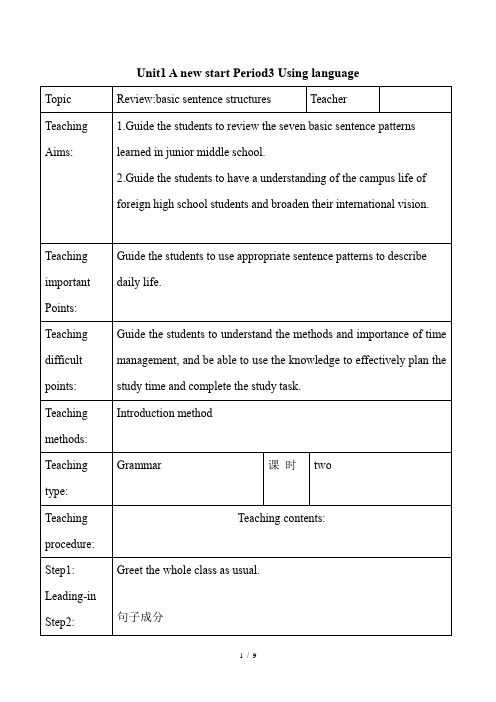
Teaching methods:
Introduction method
Teaching type:
Grammar
课时
two
Teaching procedure:
Teaching contents:
Step1:
Leading-in
Step2:
Step3:
Step4:
Summary
Greet the whole class as usual.
该句型的谓语动词常常为不及物动词;副词或介词短语在句中作状语,修饰或说明谓语动词。
She walked freelyin the space lab.
她在太空实验室里轻松地行走。
7.主谓宾状(SVOA):主语+谓语+宾语+状语
该句型的谓语动词常常为及物动词;副词或介词短语在句中作状语,修饰或说明谓语动词。
________________________________________________________
Answers:
1.I want to talk with you this afternoon.
2.Grandma told us an interesting story last night.
高一英语教案:上学期Unit 1Using Language
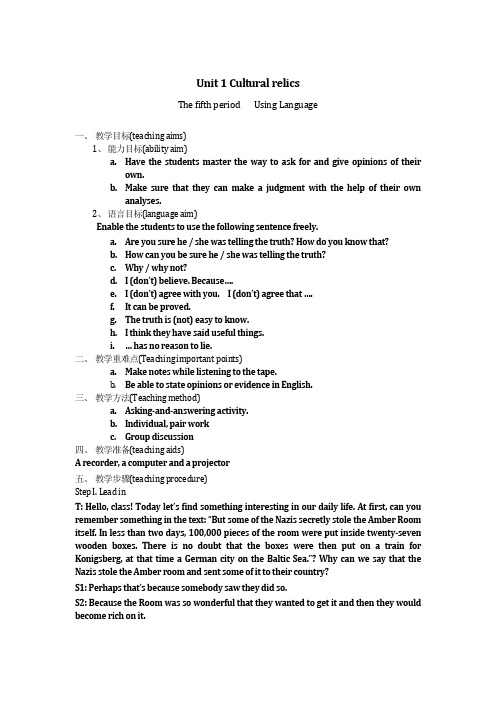
Unit 1 Cultural relicsThe fifth period Using Language一、教学目标(teaching aims)1、能力目标(ability aim)a.Have the students master the way to ask for and give opinions of theirown.b.Make sure that they can make a judgment with the help of their ownanalyses.2、语言目标(language aim)Enable the students to use the following sentence freely.a.Are you sure he / she was telling the truth? How do you know that?b.How can you be sure he / she was telling the truth?c.Why / why not?d.I (don’t) believe. Because….e.I (don’t) agree with you. I (don’t) agree that ….f.It can be proved.g.The truth is (not) easy to know.h.I think they have said useful things.i.… has no reason to lie.二、教学重难点(Teaching important points)a.Make notes while listening to the tape.b.Be able to state opinions or evidence in English.三、教学方法(Teaching method)a.Asking-and-answering activity.b.Individual, pair workc.Group discussion四、教学准备(teaching aids)A recorder, a computer and a projector五、教学步骤(teaching procedure)Step I. Lead inT: Hello, class! Today let’s find something interesting in our daily life. At first, can you remember something in the text: “But some of the Nazis secretly stole the Amber Room itself. In less than two days, 100,000 pieces of the room were put inside twenty-seven wooden boxes. There is no doubt that the boxes were then put on a train for Konigsberg, at that time a German city on the Baltic Sea.”? Why can we say that the Nazis stole the Amber room and sent some of it to their country?S1: Perhaps that’s because somebody saw they did so.S2: Because the Room was so wonderful that they wanted to get it and then they would become rich on it.T: Perhaps you are right. Well, the person who saw them do so is the most important, I think. We call such kind of person witness. But how can we decide that the witness is telling the truth? Well, let ’s have a look at some pictures. In Picture a, the man in suit is saying: “I see you ’re aiding the terrorists ”. But the other man is answering: “Dissent ”, which means that he disagrees with what the man was saying. Why? Then, let ’s say something about Picture b. The title of the pictures is: “People have been led to believe that Iraq caused 9/11”. Why is it so?(a)(b)Step II Introduce “evidence & opinion ”T: Now let ’s read two jokes. Then I ’ll ask you questions. The first one is from Belgium. A man in Belgium was arrested because police suspected that he had robbed a jewelry store. The man swore he did not do it. When the police asked if he had an alibi, he explained that he had been busy breaking into a school at the same time, Police dropped the jewelry store charges and instead arrested him for breaking into the school. Then the second: A man and his girlfriend were robbing a convenience stor. While waiting for her boyfriend to finish getting the money, the woman noticed a contest entry form. Thinking it would be cool to win, she filled out the form; complete with her name, address, and phone number, A few hours later the police were at the couple ’s house to arrest them. Do you know why the police arrested the persons?S3: Let me have a try. I think the persons in the jokes are so stupid. They told the police what they did and left a lot of information about themselves to the police.T: Very good, thank you, S3. In other words, the police got some evidences easily from them. So, what is the evidence? Please turn to P5 and listen to the tape. Then, I ’ll ask “what is an evidence and what is a fact ”.(Play the tape recorder)T: Well, who ’d like to tell me what evidence is?S4: Evidence is a fact, which can be proved.S5: An opinion is what someone believes is true but has not been proved.T: In your opinion, which is more important for the judge in a trial? S6: I think the evidence is because it is the fact.Step III ListeningT: Do you still remember that at the beginning of this period, we mentioned the German soldiers stole some of the Amber Room? Now listen to the tape and write down as much information as you can to finish the form on P5. At first, read the three forms carefully. When I play the first time, please get the main idea of it. Then try to write something down.Step IV DiscussT: Now, you’ve got so much information about the trial. In fact, the best evidence is factual and is given by a person who is most believable. The most believable eyewitness is the one who has nothing to gain from telling a lie. Do you think so, students?Ss: Yes.T: OK, now suppose that you were one of judges. Which eyewitness was giving the best evidence? Why do you say so? You may have a group discussion. While you are discussing, please use the following sentences:a.Are you sure he / she was telling the truth? How do you know that?b.How can you be sure he / she was telling the truth?c.Why / why not?d.I (don’t) believe. Because….e.I (don’t) agree with you. I (don’t) agree that ….f.It can be proved.g.The truth is (not) easy to know.h.I think they have said useful things.i.… has no reason to lie.(Students discuss for 6 minutes)T: Now, it’s time for you to present your views. Which group likes to try at first?S7:I think that all of them were giving us something useful because all of them seemed true to me. I’m puzzled.S8: I think the miner was giving the best evidence because he was working there and he was familiar with the surroundings there and he could see what the Nazis were doing very clearly.S9: I think the sailor was giving the best evidence because he helped with the boxes and he was even saved by the German soldier.T: Do you agree with them? Well, let’s see, yes, of course, the truth is not easy to know now, especially when all the facts are not known. Most of these events also happened a long time age. Perhaps people cannot remember things so clearly either, I think that all of these eyewitnesses have said useful things. However, only Anna Petrov has no reason to lie. She is not getting anything from those who are searching now for the Amber Room. So in my opinion, she is the most believable. Do you think so?Step V HomeworkT: Today we’ve learned so much about evidence and opinions. If you want to be a lawyer or a judge, today’s knowledge must be helpful to you. OK, today’s homework, Reading and writing on P7.。
高中英语Unit 1 Using language教案 新课标 人教版 必修1
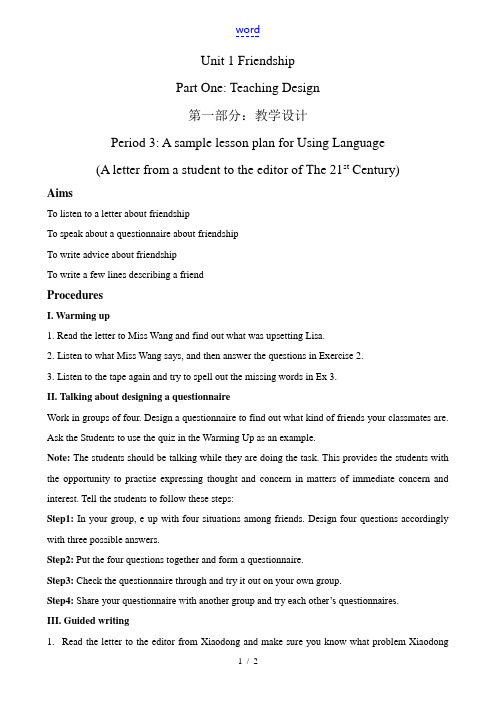
Unit 1 FriendshipPart One: Teaching Design第一部分:教学设计Period 3: A sample lesson plan for Using Language(A letter from a student to the editor of The 21st Century)AimsTo listen to a letter about friendshipTo speak about a questionnaire about friendshipTo write advice about friendshipTo write a few lines describing a friendProceduresI. Warming up1. Read the letter to Miss Wang and find out what was upsetting Lisa.2. Listen to what Miss Wang says, and then answer the questions in Exercise 2.3. Listen to the tape again and try to spell out the missing words in Ex 3.II. Talking about designing a questionnaireWork in groups of four. Design a questionnaire to find out what kind of friends your classmates are. Ask the Students to use the quiz in the Warming Up as an example.Note: The students should be talking while they are doing the task. This provides the students with the opportunity to practise expressing thought and concern in matters of immediate concern and interest. Tell the students to follow these steps:Step1: In your group, e up with four situations among friends. Design four questions accordingly with three possible answers.Step2: Put the four questions together and form a questionnaire.Step3: Check the questionnaire through and try it out on your own group.Step4:Share your questionnaire with another group and try each other’s questionnaires.III. Guided writing1.Read the letter to the editor from Xiaodong and make sure you know what problem Xiaodonghas.2.Discuss in groups of four. Think what advice you can give Xiaodong.3.Write your advice to Xiaodong as an editor individually.IV. Writing assessment1. Can you give Xiaodong some good advice?2. I s your letter well developed?3. Are your ideas well organized to the point?4.Do you have a good choice of words and idioms in your writing?5.Do you get a good mastery of plex structures of language?6.What kind of mistakes have you made in your writing? What can you do to avoid suchmistakes?V. Further ApplyingHere are some proverbs about friends and friendship. Read them carefully and pay attention to the sentence stress and intonation. Then write a passage. Choose some you agree and explain why. Then choose some you disagree and explain why.。
- 1、下载文档前请自行甄别文档内容的完整性,平台不提供额外的编辑、内容补充、找答案等附加服务。
- 2、"仅部分预览"的文档,不可在线预览部分如存在完整性等问题,可反馈申请退款(可完整预览的文档不适用该条件!)。
- 3、如文档侵犯您的权益,请联系客服反馈,我们会尽快为您处理(人工客服工作时间:9:00-18:30)。
Unit 1 Cultural relicsThe fifth period Using Language一、教学目标(teaching aims)1、能力目标(ability aim)a.Have the students master the way to ask for and give opinions of theirown.b.Make sure that they can make a judgment with the help of their ownanalyses.2、语言目标(language aim)Enable the students to use the following sentence freely.a.Are you sure he / she was telling the truth? How do you know that?b.How can you be sure he / she was telling the truth?c.Why / why not?d.I (don’t) believe. Because….e.I (don’t) agree with you. I (don’t) agree that ….f.It can be proved.g.The truth is (not) easy to know.h.I think they have said useful things.i.… has no reason to lie.二、教学重难点(Teaching important points)a.Make notes while listening to the tape.b.Be able to state opinions or evidence in English.三、教学方法(Teaching method)a.Asking-and-answering activity.b.Individual, pair workc.Group discussion四、教学准备(teaching aids)A recorder, a computer and a projector五、教学步骤(teaching procedure)Step I. Lead inT: Hello, class! Today let’s find something interesting in our daily life. At first, can you remember something in the text: “But some of the Nazis secretly stole the Amber Room itself. In less than two days, 100,000 pieces of the room were put inside twenty-seven wooden boxes. There is no doubt that the boxes were then put on a train for Konigsberg, at that time a German city on the Baltic Sea.”? Why can we say that the Nazis stole the Amber room and sent some of it to their country?S1: Perhaps that’s because somebody saw they did so.S2: Because the Room was so wonderful that they wanted to get it and then they would become rich on it.T: Perhaps you are right. Well, the person who saw them do so is the most important, I think. We call such kind of person witness. But how can we decide that the witness is telling the truth? Well, let’s have a look at some pictures. In Picture a, the man in suit is saying: “I see you’re aiding the terrorists”. But the other man is answering: “Dissent”, which means that he disagrees with what the man was saying. Why? Then, let’s say something about Picture b. The title of the pictures is: “People have been led to believe that Iraq caused 9/11”. Why is it so?(a)(b)Step II Introduce “evidence & opinion”T: Now let’s read two jokes. Then I’ll ask you questions. The first one is from Belgium. A man in Belgium was arrested because police suspected that he had robbed a jewelry store. The man swore he did not do it. When the police asked if he had an alibi, he explained that he had been busy breaking into a school at the same time, Police dropped the jewelry store charges and instead arrested him for breaking into the school. Then the second: A man and his girlfriend were robbing a convenience stor. While waiting for her boyfriend to finish getting the money, the woman noticed a contest entry form. Thinking it would be cool to win, she filled out the form; complete with her name, address, and phone number, A few hours later the police were at the couple’s house to arrest them. Do you know why the police arrested the persons?S3: Let me have a try. I think the persons in the jokes are so stupid. They told the police what they did and left a lot of information about themselves to the police.T: Very good, thank you, S3. In other words, the police got some evidences easily from them. So, what is the evidence? Please turn to P5 and listen to the tape. Then, I’ll ask “what is an evidence and what is a fact”.(Play the tape recorder)T: Well, who’d like to tell me what evidence is?S4: Evidence is a fact, which can be proved.S5: An opinion is what someone believes is true but has not been proved.T: In your opinion, which is more important for the judge in a trial?S6: I think the evidence is because it is the fact.Step III ListeningT: Do you still remember that at the beginning of this period, we mentioned the German soldiers stole some of the Amber Room? Now listen to the tape and write down as much information as you can to finish the form on P5. At first, read the three forms carefully. When I play the first time, please get the main idea of it. Then try to write something down.Step IV DiscussT: Now, you’ve got so much information about the trial. In fact, the best evidence is factual and is given by a person who is most believable. The most believable eyewitness is the one who has nothing to gain from telling a lie. Do you think so, students?Ss: Yes.T: OK, now suppose that you were one of judges. Which eyewitness was giving the best evidence? Why do you say so? You may have a group discussion. While you are discussing, please use the following sentences:a.Are you sure he / she was telling the truth? How do you know that?b.How can you be sure he / she was telling the truth?c.Why / why not?d.I (don’t) believe. Because….e.I (don’t) agree with you. I (don’t) agree that ….f.It can be proved.g.The truth is (not) easy to know.h.I think they have said useful things.i.… has no reason to lie.(Students discuss for 6 minutes)T: Now, it’s time for you to present your views. Which group likes to try at first?S7:I think that all of them were giving us something useful because all of them seemed true to me. I’m puzzled.S8: I think the miner was giving the best evidence because he was working there and he was familiar with the surroundings there and he could see what the Nazis were doing very clearly.S9: I think the sailor was giving the best evidence because he helped with the boxes and he was even saved by the German soldier.T: Do you agree with them? Well, let’s see, yes, of course, the truth is not easy to know now, especially when all the facts are not known. Most of these events also happened a long time age. Perhaps people cannot remember things so clearly either, I think that all of these eyewitnesses have said useful things. However, only Anna Petrov has no reason to lie. She is not getting anything from those who are searching now for the Amber Room. So in my opinion, she is the most believable. Do you think so?Step V HomeworkT: Today we’ve learned so much about evidence and opinions. If you want to be a lawyer or a judge, today’s knowledge must be helpful to you. OK, today’s homework, Reading and writing on P7.。
